Feeding Pigs From The Nursery To Finishing
Introduction
There are a number of challenges facing the pig industry as it becomes more specialized and
performance targets increase with the widespread use of UK stock of superior genetic potential. This
paper will consider some of the recent nutritional developments, which aim to realise this potential.
It will be divided into a number of sections based on the specific age of the animal being considered.
The Piglet Post-weaning
The animals in the immediate post-weaning period have problems. They are weaned between 16-
28 days of age (sometimes earlier), are physiologically and immunologically immature (thus although
they can respond to a pathogen attack they have little passive immunity. They are also environmentally
and socially stressed. The end result is that they experience digestive upsets, pathologies, dehydration
and as a result mortality can be significant.
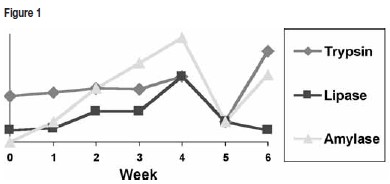
Specific problems with respect to digestion are that animals often have difficulty achieving low and uniform gastric pH (optimum for gastric proteases is pH 3.5) because of HCl inadequacy, inefficient mixing of gastric contents, and deficiency in production of endogenous enzymes. (see Figure 1; weaning was at four weeks)
Inefficient gastric digestion leads to passage of micro-organisms into small intestine (Coliforms, Anaerobes), reduced protein digestion (substrates which can be fermented by bacteria in to toxins including ammonia and aromatic / biogenic amines which will damage gut mucosae and excessive hind gut fermentation which will lead to diarrhoea / dedydration.
There are also problems with piglet food itself. It may contain many contaminants (Mould / Yeasts / Bacteria). The diet should of course be highly nutritious; unfortunately crude protein / minerals / amino acids have high buffering (acid-binding) capacity such that achieving optimum gastric pH may be difficult. In the UK, diets are based increasingly on vegetable proteins which may contain anti-nutritional / antigenic factors and are less digestible. The sudden change from liquid to dry / pelleted diets can present problems and in addition water intake may be reduced.
Some people have looked at sow milk in an attempt to design post-weaning diets. However, lactose (milk sugar) is digested by lactase and levels of this enzyme enzyme fall following weaning. Fat in milk emulsified in fine droplets whereas fat added to dry diets is not, so digestibility is reduced (and, in any case, fat in dry diets at the high levels found in milk would be hard to manufacture / pellet. Protein from milk is highly digestible but it is difficult to find raw materials with similar digestibility. Any reduction in digestibility will lead to excessive amounts of nutrients made available for bacterial fermentation.
There is increasing interest in starch. It is the principal energy-yielding ingredient in cereals and it undergoes some major changes during heating, which in theory increase susceptibility to a – amylase. When heated in the presence of water crystals swell, structure begins to break down. At around 600 C becomes irreversible leading to gelatinsation, which should improve starch digestibility. At very high temperatures and cooling there is increase in ‘resistant’ starch, which cannot be digested. This is another example of the importance of defining optimum processing conditions.

Table 1 above shows some of the key raw materials used in piglet diets. What is particularly important to note is that growth promoters are now being phased out. It is for this reasons that the UK pig industry is at the forefront of nutritional developments as it seeks to design nutritional strategies, which do not use substances, which are widely used in many other parts of the world.
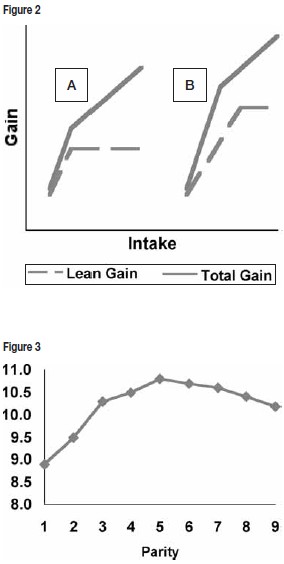
The Growing Finishing Pig
Performance assessment is traditionally based
on daily live weight gain (DLWG) giving days to
slaughter, food intake (FI) and food conversion
ratio (FCR). More recently others have been used
including lean tissue growth rate and efficiency
of lean tissue accretion, bearing in mind the value
of these in the modern high potential UK herd.
It is critical to understand animal requirements in order to formulate the best diets. Animals do have maintenance requirements but it is those for production that are the more important as far as pig nutritionists are concerned. These have been based on live weight gain and growth rate but increasingly it is the composition of live weight gain which is being examined; this is based on genotype, sex and level of feeding. The energy required for 1 kg of lean and fat deposition is respectively 1 kg of protein = 43.9MJ of ME and 1 kg of fat = 53.5 MJ of ME.
Energy requirements are of course linked to protein requirements which are assessed in terms of the Ideal protein’ concept. Pigs have requirements for amino acids, which are either Essential (must be present in the diet) or Non-Essential (may be synthesized in vivo). The Ideal protein contains all essential amino acids in the correct proportion and some non-essential ‘protein’ which the animal can then utilize in amino acid synthetic pathways.
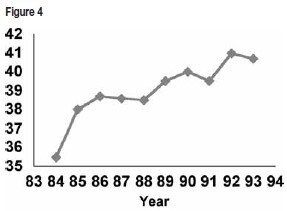
The content of each essential amino acid is referred to lysine. At its simplest, once an absolute requirement for lysine has been established and then requirements for all other amino acids may be calculated. For example, with a lysine requirement of 25 g/d, the requirements for Threonine would (from ARC figures) be 25*0.6 = 15 g/d. There is considerable debate on the ration of Threonine to Lysine (0.6 in the example above ratio; many believe that it should be higher, particularly in modern highperforming genotypes. There is also considerable debate on the necessary dietary quantity of nonessential nitrogen, not least because excess nitrogen may lead to greater nitrogen excretion, which has pollution potential. Estimates are of the order of 60% of total dietary nitrogen.
The influence of genotype and energy intake on the composition of gain is shown in Figure 6 below. Protein deposition is an energy-expensive activity and high quality animals (B) need high intakes. If however a diet designed for one of these animals is fed to a poor quality genotype (A) the result will be excessive fat deposition.
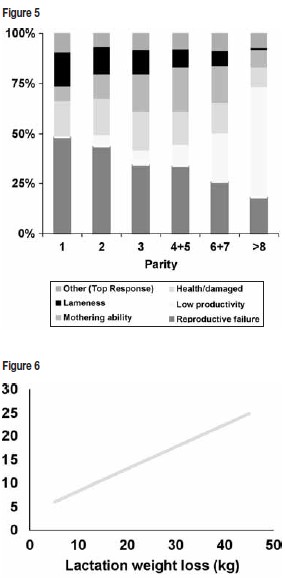
Finally it is very important not to forget trace elements, which are essential components of pig diets. Macronutrients include Ca, P, Salt, Essential fatty acids which are usually supplied as specific raw materials (e.g. Dicalcium Phosphate) and Micronutrients which are all other minerals and vitamins usually supplied as a ‘premix’. Ca and P requirements for optimum bone mineralisation are more than those for performance, which is not a problem for meat animals, but can be for breeding stock.
Breeding Stock
The Lifetime performance of each breeding sow
is very important and output should be 60 piglets
weaned and age at culling should around 3 years.
The most productive parities are around number
5 and 6 (see Figure 5 below).
However it is becoming increasingly evident that sows are not lasting for 6 parities, as seen in figure 6 below.
Although the figure has stabilized it is still high at around 42% in the UK (although it is much higher in many other countries).
However, closer examination of data which measure why sows are culled do reveal worrying trends (see Figure 5). Nearly 50% of gilts are culled after their first litter because of reproductive failure (usually because of failure too re-breed following weaning) and around 16% because of lameness. This has prompted a considerable amount of research work to investigate the origin of these problems.
Modern gilts have higher potential lean tissue growth rate, lower potential for fat deposition, reduced feed intake capacity (VFI), increased mature body size, increased mature lean tissue mass, earlier age at puberty and must develop adequate bones. Optimum gilt diets should have higher nutrient and energy content than for meat animals and the two should be separated and fed differently. If gilts are fed properly during rearing then these problems should become less serious
Pregnancy nutrition can be divided into a number of phases
• Days 1-28
– Avoid over-feeding
• Days 28-56
– Increase feed level
• Promotes secondary muscle fibre development in foetus
• Better performance in growing / finishing phase
• Days 56-75
– No benefits from increased feeding
• Days 75-95
– Encourage mammary growth development (secretory cells)
• higher protein intakes but not energy.
• Days 95 – farrowing
– Increase feed allowance
• May improve piglet survival but not birth weight
• Avoid excessively fat sows
For sows
• avoid fat animals at farrowing - 22mm P2
• target DE intake around 35MJ/d = 10-12 kg fat accretion
• body condition of each animal must be considered
For gilts
• animal is still growing
• knowledge of LTG of genotype is essential
• achieving 22mm P2 not possible in modern genotypes
– protein restriction is not advised
• Increasing feed levels in last 2.5 weeks of pregnancy recommended
During lactation, energy and nutrient demands are considerable, the more so the longer the lactation period itself. Mobilization of body reserves (both fat and lean) is inevitable as gilts / sows are unable to consume sufficient to meet demands. Loss of condition always occurs and may reduce success of re-breeding. The objectives of lactation nutrition are to minimize losses of condition.
The key to successful lactation nutrition is to develop strategies, which promote intake, is to use high quality, palatable diets and a step-wise increase in quantities of feed offered. Liquid feeding systems may be of value. Ambient temperature is important; if it is too warm, intake falls and both sow and piglets differ. This however is a difficult area to control optimally.
Re-breeding following weaning is a critical phase in pig production. Excessive loss of condition during lactation will increase weaning to oestrus interval, delay return to oestrus and may even result in complete failure to exhibit oestrus. The optimum interval from weaning to oestrus is 6-9 days. Figure 6 below shows he relationship between lactation weight loss and weaning to oestrus interval. The gilt is much more sensitive to lactation weight loss than the sow.
Ovulation rate may also be adversely influenced by lactation weight loss as shown in Figure 11.
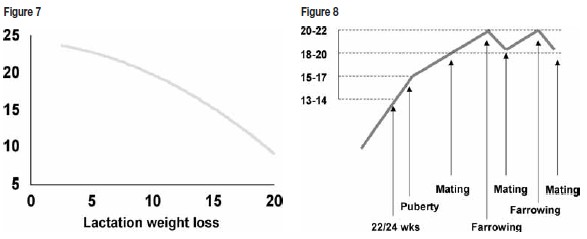
The key is to monitor changes in condition score / backfat measurements during the lifetime of the animal. The former is easier if experienced staff is used. However ultrasound measurement of P2 are more accurate. Figure 8 shows target backfat depths (in mm) for a sow over two cycles.
It is important to plan nutritional strategies for individual sows based on their condition rather than assuming a herd average will be satisfactory.
Conclusion
The modern pig is capable of achieving high levels of productivity but only if nutritional inputs are
accurately designed and monitored
University of Nottingham
United Kingdom
Tags · Feeding Pigs From The Nursery To Finishing
This article hasn't been commented yet.


Write a comment
* = required field